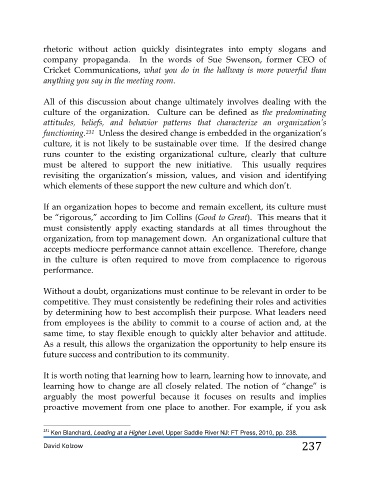Page 237 - 4- Leading_from_Within
P. 237
rhetoric without action quickly disintegrates into empty slogans and
company propaganda. In the words of Sue Swenson, former CEO of
Cricket Communications, what you do in the hallway is more powerful than
anything you say in the meeting room.
All of this discussion about change ultimately involves dealing with the
culture of the organization. Culture can be defined as the predominating
attitudes, beliefs, and behavior patterns that characterize an organization’s
functioning. 231 Unless the desired change is embedded in the organization’s
culture, it is not likely to be sustainable over time. If the desired change
runs counter to the existing organizational culture, clearly that culture
must be altered to support the new initiative. This usually requires
revisiting the organization’s mission, values, and vision and identifying
which elements of these support the new culture and which don’t.
If an organization hopes to become and remain excellent, its culture must
be “rigorous,” according to Jim Collins (Good to Great). This means that it
must consistently apply exacting standards at all times throughout the
organization, from top management down. An organizational culture that
accepts mediocre performance cannot attain excellence. Therefore, change
in the culture is often required to move from complacence to rigorous
performance.
Without a doubt, organizations must continue to be relevant in order to be
competitive. They must consistently be redefining their roles and activities
by determining how to best accomplish their purpose. What leaders need
from employees is the ability to commit to a course of action and, at the
same time, to stay flexible enough to quickly alter behavior and attitude.
As a result, this allows the organization the opportunity to help ensure its
future success and contribution to its community.
It is worth noting that learning how to learn, learning how to innovate, and
learning how to change are all closely related. The notion of “change” is
arguably the most powerful because it focuses on results and implies
proactive movement from one place to another. For example, if you ask
231
Ken Blanchard, Leading at a Higher Level, Upper Saddle River NJ: FT Press, 2010, pp. 238.
David Kolzow 237

